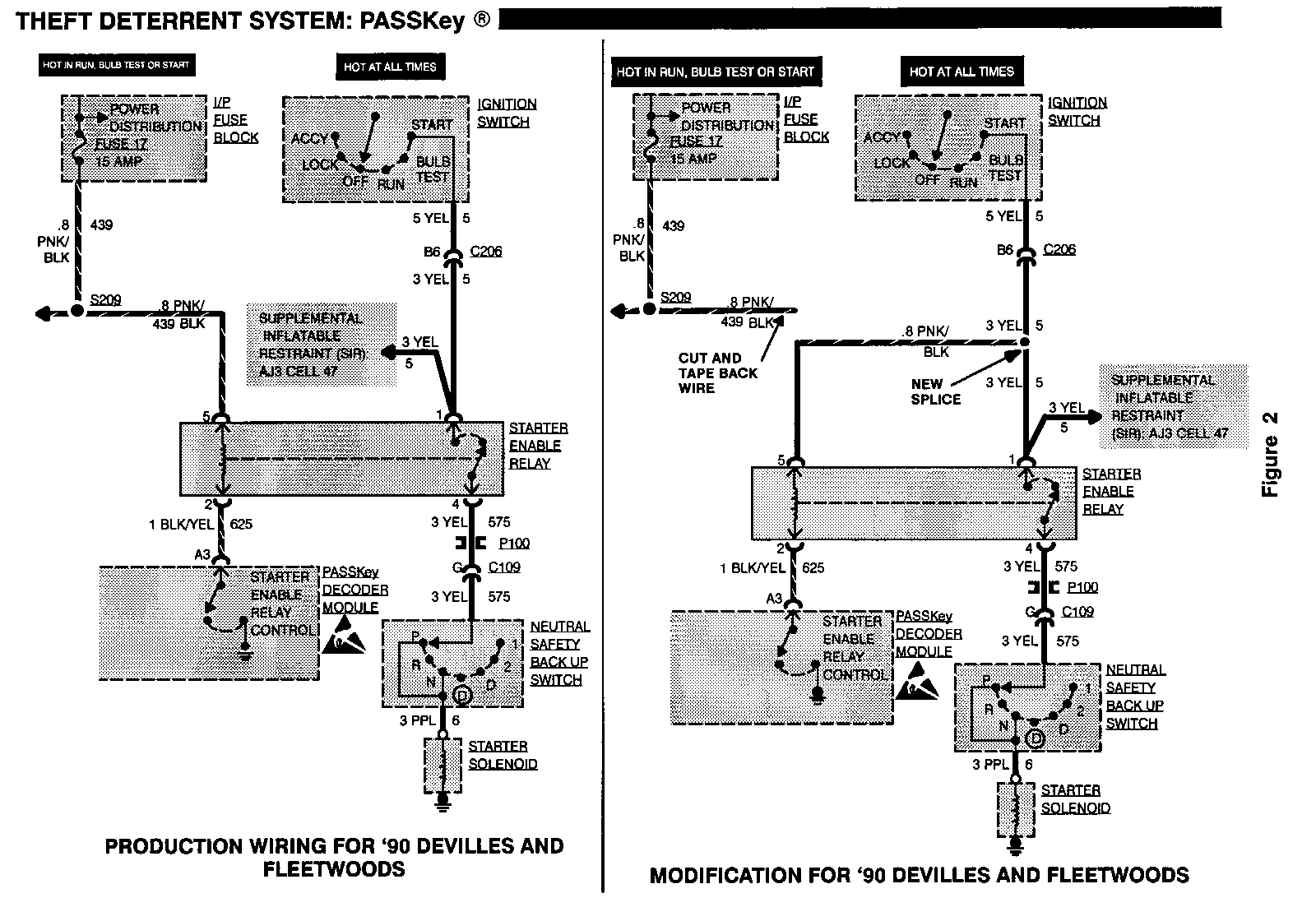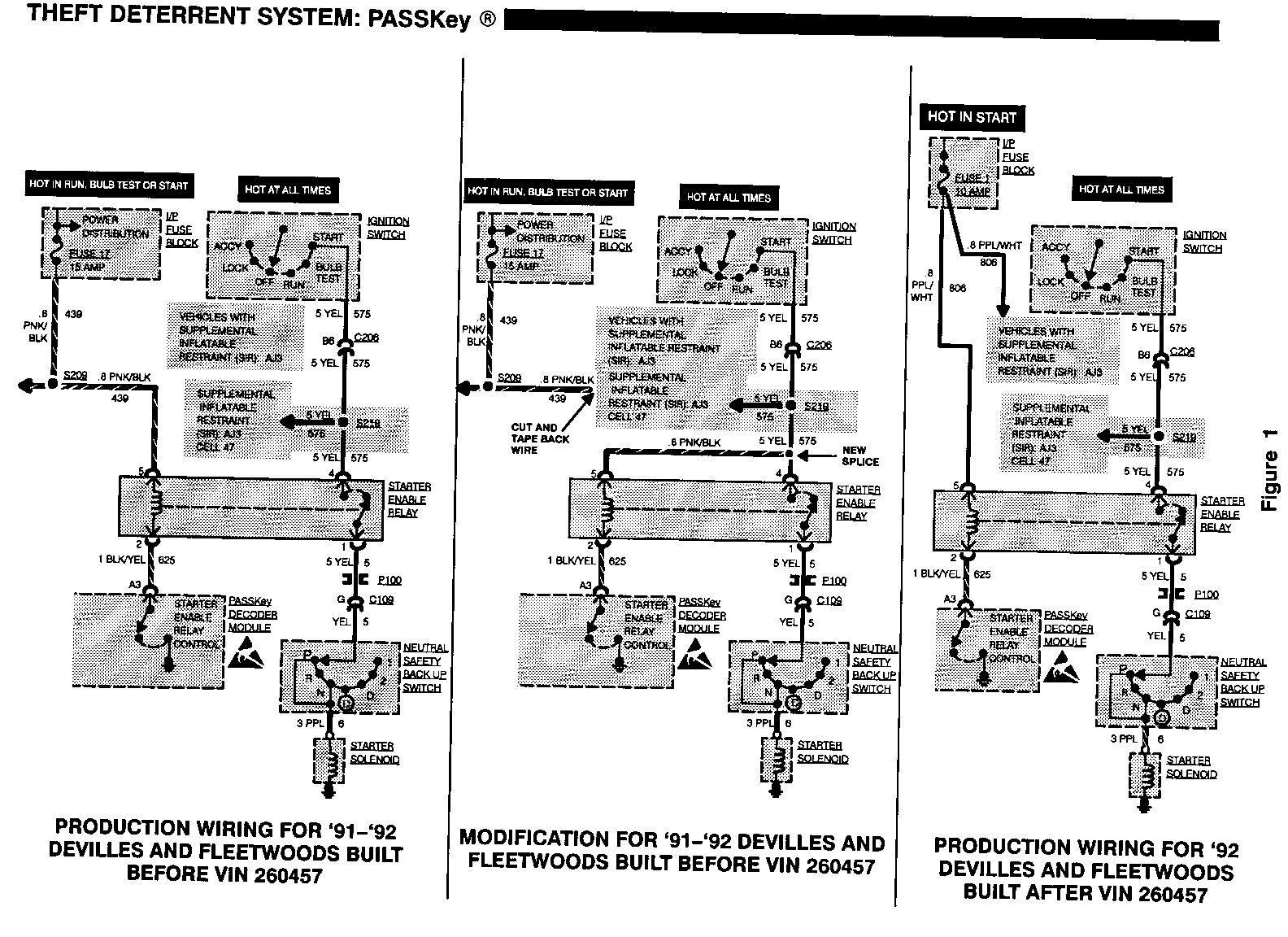INTERMITTENT NO START/NO CRANK DUE TO THE PASSKEY

SUBJECT: INTERMITTENT NO START AND/OR NO CRANK DUE TO PASSKey
MODELS AFFECTED: 1989-1992 ELDORADOS AND SEVILLES 1989-1992 ALLANTES 1990-1992 DE VILLES AND FLEETWOODS
This bulletin is being revised to include VIN breakpoints for 1992 DeVilles and Fleetwoods, revised relay location and wiring for 1990 DeVilles and Fleetwoods, and a correction in the essential tool part number. This bulletin supersedes Service bulletin T-91-96A.
Intermittent no starts on 1989-1992 Eldorados, Sevilles, and Allantes and 1990-1992 DeVilles and Fleetwoods may be caused by PASSKey. This is to highlight possible causes of intermittent no start or no crank conditions due to PASSKey. For no start conditions which can be repeated, use the diagnostics in Section 8A of the 1991 Service Information Manual.
SYSTEM OPERATION
The security telltale or message and the three minute wait timer can provide information to aid in diagnosing no starts. The security light should come on for bulb check at key on and go off after crank. If the PASSKey system reads an improper key value, the customer will have to wait three minutes before trying again to start the vehicle; and the security telltale or message will turn on. (If the PASSKey system doesn't detect a key input at all, the security telltale will never bulb check or turn on.)
SYSTEM DIAGNOSIS
Ask the customer about the following light, message, and wait timer conditions when the vehicle did not start:
1. The security light or message functions normally (bulb check for two seconds then turn off), and the vehicle may start within three minutes of condition. Go to RELAY #3.
2. The security light or message remains on during condition, and the car cannot be started within three minutes of condition... OR The Security light or message is off during condition, and the vehicle may start within three minutes of condition. Proceed to KEYS #1 then LOCK CYLINDER #2.
3. The vehicle cranks but does not start. Proceed to CRANK/NO START.
If no information is available from the customer, proceed to KEYS, #1, and perform the DIAGNOSIS/CORRECTION steps in the order listed until the condition is corrected.
DIAGNOSIS/CORRECTION NO START/NO CRANK
1. KEYS
Check ALL of the customer's keys. Check the key pellets visually for looseness or damage. Check the keys using a PASSKey Interrogator (J-35628-A) or ohmmeter for proper key code. If the display changes value or reads "E", replace the key. The key codes should all match.
The remainder of the intermittent problem diagnosis depends upon ALL of the keys that the customer may use to start the car being checked and verified as OK.
2. LOCK CYLINDER
Check the lock cylinder and column wiring by installing the J-35628-A at the connection at the base of the steering column. For Devilles and-Fleetwoods use the J-35628-90 48-way adapter with the Interrogator. Cycle the key through the on and crank positions (at least three times) and observe the code display. If the display changes value or reads "E", replace the lock and cylinder assembly.
An open or short to ground in the lock cylinder or PASSKey column wiring will cause the security telltale to not bulb check or illuminate during the condition. Resistance in the column or key contacts may cause the security telltale or message to turn on and a three minute wait timer to start.
IMPORTANT: DO NOT REPAIR lock cylinder wiring or terminals inside the column. The lock cylinder and pigtail must be replaced if wiring or terminals at the lock cylinder are intermittent. Keys of The proper PASSKey code must be cut to match the module that is in the car and the new mechanical coding of the new lock cylinder. See Section 9D of the Service Information Manual for the procedure.
DO NOT REPLACE THE PASSKey MODULE WHEN REPLACING THE LOCK CYLINDER AND KEYS.
WHEN DIAGNOSING, DO NOT SUBSTITUTE A NEW PASSKey MODULE ON A VEHICLE WITH A SUSPECTED COLUMN WIRING OR KEY CONDITION. THE NEW PASSKey MODULE MAY LEARN AN IMPROPER KEY CODE AND NOT BE USEABLE ON ANOTHER CAR.
3. RELAY
DeVilles and Fleetwoods - If the column wiring and keys are OK, replace the relay and modify the wiring as follows:
IMPORTANT: The wiring modification should only be performed on all 1990 and 1991 vehicles and 1992 vehicles built before VIN 260457. Vehicles built after this breakpoint have the modified wiring changes. Refer to Figure 1 for 1991-1992 vehicles. Refer to Figure 2 for 1990 vehicles.
1991-1992 Vehicles:
1. Remove fuse 17 from I/P fuse block.
2. Remove glove box.
3. Remove resistor module.
4. Remove starter enable relay screw from BCM bracket.
5. Disconnect starter enable relay.
6. Cut circuit 439 (PNK/BLK wire) far enough from relay connector to allow for splicing. Strip the relay side of the wire for splicing. Tape back the harness side of the wire. Refer to Figure 1 for wiring modification schematic.
7. Cut circuit 575 (YEL wire) far enough from relay connector to allow for splicing. Strip both harness and relay sides of circuit 573'for splicing.
8. Splice the three wires (both 575 wires and the 439 wire) together with a splice clip, P/N 1839906, which can be found in terminal repair kit tool J-38125. Follow the procedure for "splicing copper wire using splice clips" in the 1991 Service Information Manual on page 8A-5-2.
9. Replace starter enable relay with new P/N 25609047.
10. Replace fuse 17 into I/P fuse block.
11. Start vehicle.
12. Turn key off.
13. Install relay into BCM bracket.
14. Install resistor module.
15. Install glove box.
1990 Vehicles:
1. Remove fuse 17 from I/P fuse block.
2. Remove left sound insulator.
3. Remove starter enable relay screw from steering column support bracket.
4. Disconnect starter enable relay.
5. Cut circuit 439 (PNK/BLK wire) far enough from relay connector to allow for splicing. Strip the relay side of the wire for splicing. Tape back the harness side of the wire. Refer to Figure 2 for wiring modification schematic.
6. Cut circuit 5 (YEL wire) far enough from relay connector to allow for splicing. Strip both harness and relay sides of circuit 5 for splicing.
7. Splice the three wires (both 5 wires and the 439 wire) together with a splice clip, P/N 1839906, which can be found in terminal repair kit tool J-38125. Follow the procedure for "splicing copper wire using splice clips" in the 1990 Service Information Manual on page 8A-5-2.
8. Replace the starter enable relay with new P/N 25609047.
9. Replace fuse 17 into I/P fuse block.
10. Start vehicle.
11. Turn key off. 12. Install relay into steering column support bracket.
13. Install left sound insulator.
Eldorados, Sevilles, and Allantes:
If the column wiring and keys are OK, replace the starter enable relay, P/N 25609047 (1992 Eldorados and Sevilles should use P/N 14100455).
Parts are currently available from GMSPO.
Refer to Section 9D or Section 8A, Cell 133, of the appropriate Service Information Manual for the location of the starter enable relay.
In these cases, the customer may indicate that rapidly cycling the key from off to crank will allow the vehicle to crank and start. The three minute wait timer will not delay a restart. The security telltale will bulb check normally and will not illuminate to indicate a PASSKey problem.
4. PASSKey CIRCUITS KEY INPUT
If the condition remains, disconnect the PASSKey module and check the resistance between A6 and B2 with the key in the ignition. The resistance should be within 10 ohms of the key pellet resistance as checked with an ohmmeter. Check wiring between the column and the PASSKey module while watching the resistance between A6 and B2. If the resistance changes, recheck for intermittent connection at the lock cylinder to the key, shorts or opens in the column, at the connector at the base of the column, or between the column and PASSKey module in circuits 1073 and 1074. See notes under step 2 for diagnosis of telltale, message and wait timer moding for opens, shorts to ground and improper resistance.
5. PASSKey MODULE WIRING
Check the power and ground to the PASSKey module. intermittent power or ground at the module may cause the security telltale to bulb check multiple times.
DIAGNOSIS/CORRECTION CRANKS/NO START
The PASSKey system is allowing the car to crank, so the lock cylinder, key and wiring to the PASSKey module are OK.
The condition may be an open or short to ground or voltage between the PASSKey module and PCM, in circuit 229. Sometimes the condition will have occurred with the engine running and a Code E58 or E058 will set.
To try to duplicate the intermittent condition, clear codes, exit diagnostics, and start the engine. Check circuit 229 connections or wiring between the PASSKey module and PCM. If the condition is duplicated (229 open or shorted), a message will turn on.
See Section 6E-A to check for fuel injection causes of crank/no-start.
IMPORTANT:
o When diagnosing intermittent no start/no crank, also check items such as battery, starter, neutral safety backup switch (NSBU or PRNDL switch).
o When diagnosing crank/no start, check for PCM codes that would indicate ignition or fuel injection causes.
WARRANTY INFORMATION VEHICLE SERIES Operation Operation Description Number C D E K V --------------------- --------- ------------------------------ Ignition Lock Cylinder E7200 1.3 1.0 1.0 1.4 Theft Deterrent Interrupt Relay N2910 .4 .4 .4 .5 Rewire Starter Enable Relay T6554 .6 - - -


General Motors bulletins are intended for use by professional technicians, not a "do-it-yourselfer". They are written to inform those technicians of conditions that may occur on some vehicles, or to provide information that could assist in the proper service of a vehicle. Properly trained technicians have the equipment, tools, safety instructions and know-how to do a job properly and safely. If a condition is described, do not assume that the bulletin applies to your vehicle, or that your vehicle will have that condition. See a General Motors dealer servicing your brand of General Motors vehicle for information on whether your vehicle may benefit from the information.
